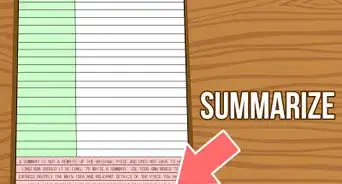wikiHow is a “wiki,” similar to Wikipedia, which means that many of our articles are co-written by multiple authors. To create this article, 53 people, some anonymous, worked to edit and improve it over time.
This article has been viewed 416,195 times.
Learn more...
Classroom discussion is a time-honored way to learn. It is also an evidence-based way to help students retain information,[1] pay attention,[2] and gain real insight. However, if you're a discussion leader, you may be nervous. Preparing for, opening, and continuing a great discussion is a skill you can learn. These steps advise you on every aspect of leading a good discussion, from keeping everyone engaged, to managing strong personalities, to wrapping up the discussion. So if you find yourself needing to lead a class in college or high school, or if you are simply interested in alternative ways of learning, practice these skills and make them your own. Soon you will be on your way to leading engaging and thought-provoking discussions where everyone learns -- including yourself!
Steps
Opening the Discussion
-
1Ask a question that inspires a productive conversation. The best questions are neither too open-ended nor too limited. "Yes or No" questions halt discussion, while overly broad questions (such as "What do you think about Romeo and Juliet?") questions also tend to discourage discussion. The best questions are balanced; they are open enough that there seem to be a few good answers, yet closed enough that people know how to approach them, and feel motivated to start talking.[3]
- For example, suppose you're discussing Romeo and Juliet. You may start by asking, "In what ways does the Friar make mistakes in guiding Romeo? In what ways does he succeed?" This question doesn't feed any answers, but leads students in a productive direction.
-
2Be prepared. As the discussion leader, you should come into the meeting with several "big" questions. Be prepared to ask the next one when discussion dies down, when people need more food for thought. The more prepared you feel when you walk into a classroom, the more confident you'll look. If you look confident in your ideas and your approach, students will be more likely to respect you and to cooperate.[4]
- It can be helpful to give participants 1-2 questions in advance to give them more time to provide thoughtful contributions when the discussion comes.
- Also, it can be helpful to give participants the questions you'll discuss in class, on paper, or on the board. Some students learn better and think more effectively if they have the questions out in front of them. This can also be an excellent reminder of the main question for the day.
- In a 2 hour discussion, 2-5 good questions should suffice. It is also good to have 2 or 3 smaller sub-questions for each main question. However, you should prepare for at least 1.5 times as much material as you think you'll cover, just in case students are particularly reticent that day or in case one line of inquiry wasn't as fruitful as you thought it was.
Advertisement -
3Provide clear guidelines for participation. Everyone knows how to have a conversation; but a thoughtful discussion is more intentional and more focused than just a chat. If you want to start the conversation off on the right foot, then let the students know exactly what your expectations are. Should students raise their hand before speaking? Or should they speak freely without raising their hands? Should they use "Mr." and "Ms." when addressing their fellow students? These details clarify expectations and hence increase student confidence. You might also coach students on how to avoid personal biases in their responses, or any terms to use or avoid, and what to do if the discussion gets heated.[5]
- If you have a handout with “Dos” and “Don'ts” listed on it, this can help students stay on track, too.
-
4Provide a shared frame of reference, such as a book, video, or other media. It's important for you and the students to have something you can all talk about before you begin the discussion. This can be almost anything: the assigned reading for that day's class, a news story or poem, a work of art, or even a natural object like a sunset. The important thing is that you and the students share a common object of study so the discussion can be concrete instead of wallowing in abstractions.
- Make the expectations for being prepared clear. If you don't have incentive for students to do the homework or consequences for students who are unprepared, then they'll be less likely to come to class with fresh, exciting ideas.
-
5Maintain enthusiasm for the topic. One way to make sure that the discussion goes well is to show your enthusiasm for the subject right from the beginning. If you have engaged body language, are alert and energetic, and show how the topic is important to your life and the lives of the students, they'll be much more likely to be engaged. If they think that you're tired, apathetic, or just trying to get the discussion over with, then they'll be less likely to care.[6]
- Even if a topic isn't inherently fascinating, don't try to cushion the blow by saying, “I know this isn't that exciting, guys…” Instead, show that the topic is worth caring about; your students will follow.
- Sometimes, showing that something has real-world applications can help your students care about it. If you're studying a historical event, for example, then starting off the class with a news article about an event with similar themes or values behind it — such as current protests against discrimination in relation to race riots of the 1960s — can help students stay engaged.
-
6Define key terms. One helpful way to begin the discussion is to define any key terms that may be useful to your students throughout the discussion. For example, if you're giving a lesson on poetry, you can discuss simile, metaphor, allusion, or any other literary devices that are central to the poem. If all of your students feel like they're on the same page and have a strong foundation before they begin the discussion, then they'll be much more confident about participating.
- Even if it feels like you're oversimplifying things a bit, it's better to have everyone on the same page before the discussion really kicks off than to lose a few students. Some students may be too shy to admit they're confused about some of the more simple terms, and it's important to explain them before you can move forward.
-
7Present yourself well. In order to lead a meaningful discussion, you should strike a balance between confidence about what you know and a willingness to learn more. A discussion is an adventure -- you may not know exactly where it will go, but you can lead the way. If you are willing to be vulnerable in showing that you don't know everything, students will be more likely to be vulnerable too.
- Present yourself as a professional in dress and body language: stand tall, make eye contact, and smile.
- Be genuinely excited about your students' ideas to help generate enthusiasm for the topic. Point out great comments and ask the student to repeat it. They may not even realize that they made a great comment!
Maintaining a Meaningful Conversation
-
1Maintain an atmosphere of safety and respect. One of your most important jobs is creating an atmosphere of respect, even respectful disagreement. If you want to encourage your students to participate, then you have to give them a safe environment for doing so. You have to make it clear that all of the students deserve respect and that no one will be made to feel unworthy because of their ideas or opinions. You should treat students positively and reward them for contributing.[7]
- And never make them feel stupid, and don't let other students do so. If a student is being rude to another student, address the problem head-on instead of letting the conversation go on; if you say nothing, you'll make it look like it's acceptable for students to be rude to each other.
- Encourage students for speaking instead of tearing them down. Make them feel excited to join the discussion, instead of self-conscious.
-
2Make arguments. Don't just share your feelings or opinions without backing them up. If you're discussing Romeo and Juliet and someone asserts, "The Friar shouldn't have given Romeo any advice!" ask them why that is so. Discuss possible support or objections to their claim. Use the "Pros and Cons" model; argue for a position, and then let students argue against it (or argue against it yourself!). Ask: which conclusion would hold up better in a court of law? This can lead to meaningful results without having the students feel like you're spoon-feeding them the answers.[8]
- Help guide students to reach conclusions for themselves. If the objective of the discussion is only to make the students see the “right” answer, then you might as well have lectured at them instead.
-
3Move from the known to the unknown. No one can learn if they know everything already; and no one can learn if they know nothing. A good discussion begins when we realize we know something but need to learn more. Even if you feel you have answered a question, press deeper. Find another puzzle you don't yet understand, or move to the next area of interest. Once you've established something you and the group have puzzled out, move on to a new, more complicated mystery. Use your previous discussion as a reference point and continue to dig deeper.
- Treat each new “unknown” as an exciting mystery that the students will solve together. Even if you've already thought it through, act like you're figuring it out right along with them.
-
4Manage personalities. Some students love to discuss and debate; others feel anxious speaking in a group. Give space to each different person, and don't worry if you sometimes make mistakes. Make sure every participant has an opportunity to be heard. Some will not take the opportunity, but they will feel cared for that it was presented. Work to make sure that every student is heard, and that some students aren't heard too much. Make it so students with conflicting personalities don't have misunderstandings and that everyone gets along, for the most part.
- For the more talkative student, here are a few tips: 1. Ask them to speak only 5 times that day and make them keep track of their comments; this allows them to decide which comments are really important. 2. Ask them to help lead the discussion; let them ask questions and not just answer your questions every time. 3. Invite them to write out their thoughts and present a conclusion at the end of class. 4. Tell them that they get a turn to speak every time a quieter person speaks first; this will encourage them to balance each other out.
- For the quieter student, here are a few tips: 1. Try specifically ask the quieter members what they think of the topic. 2. Invite them to write their thoughts out and offer to read their thoughts to the class at the beginning of the next discussion. 3. Allow room for silence and reflection while "internal processors" think through the discussion.
- Be aware of the different personality types in your classroom and of how they succeed the most in group discussions. For example, if you have a student who likes to absorb the conversation and then weigh in toward the end, let this student take the time he needs instead of forcing him to speak when he's not ready.
- Don't take it personally if some students refuse to participate. They may have other things going on in their life, such as social anxiety or family stress, that make it difficult for them to engage. Encourage them, if possible, that their presence matters.
-
5Write ideas down. One technique to help maintain a productive class discussion is to write down the ideas of your students throughout the discussion. This can remind students of what you're talking about and can give them something to point back to. You can even write their ideas down in a slightly more articulate way to help frame the discussion. If you do this, though, make sure you write down most of the ideas that are said so some students don't feel discouraged if you don't write down their ideas.[9]
- You can even consider having one student as a designated “note taker” who stands at the board and writes down the ideas as they come.
-
6Remember that it's about the topic, not you. When you lead a class discussion, you may be feeling self-conscious and thinking that if it's not going well, that it's because the students don't like you or respect you. This negative thinking will only discourage you instead of focusing on the topic at hand. If your students aren't responding well or aren't as engaged as they could be, then remind yourself that this is because the topic could be presented in a new light, not because there's something wrong with you.
- Once you stop focusing on there being something wrong with you, you'll have more freedom to turn to the discussion topic and to make the conversation as dynamic as possible.
-
7Manage your time well. One important aspect of leading a discussion is making sure that you hit most of the important points you wanted to hit. If students get too stuck on one point that isn't central to the discussion, then you can move the conversation along to the more important aspects of the day's material. That said, if you find that students are having a fascinating conversation about something you didn't intend to hit and that they are really learning from each other, then you can continue to use this time to explore a new line of thinking.
- Time management is an important part of leading a class discussion. It's important to keep the students on track and avoid talking about one minor quibble for the entirety of your class time.
- Find a way to subtly check the clock or your watch from time to time. You don't want to make the students nervous when you do this.
- Give students a "two minute warning" to allow them to slow down, reflect, and present any closing thoughts or last words.
-
8Help students address each other. One way to help move the discussion forward is to help students talk to each other instead of to you. As long as the conversation is respectful and well-meaning, then having them directly address each other's points can help them get to know each other and can facilitate a meaningful discussion without any barriers. If you find that this technique is making the conversation too aggressive or argumentative, then you can pull students back a bit.[10]
- Having the students talk to each other more can lead to a more dynamic, exciting discussion. They'll feel like they can talk more openly if they're talking to each other instead of just addressing the teacher.
- Just make sure to stress that they should do this in a respectful manner and that focuses on the person's ideas, not the person.
-
9Manage problem students. Unfortunately, just one problem student can ruin an entire discussion. If there's a person in your class who always talks out of turn, interrupts others constantly, puts down the views of others, or just generally disrespects you and the other students, then you need to work on addressing the problem head-on as quickly as you can so this one student doesn't keep the others from learning. You can first try to address the problem in class, and if that doesn't work, you can pull the student aside and talk about his or her behavior privately.[11]
- There are many kinds of problem students. For example, if one of your students talks out of turn, stress the importance of raising his hand before he speaks.
- If you have a student who talks too much, tell him to wait until at least four other people have spoken before contributing again. Though this may sound harsh, it can help this student focus on listening to what others have to say.
- Occasionally, though thankfully not very often, an overbearing participant may need to be removed from the discussion. Mostly, such students respond well to gentle but firm correction. It does happen, though, that a student refuses to play by the rules. It is not fair to the participants who want to learn to allow one person to ruin the discussion. If possible, and after many warnings, you may want to find a way to organize the discussion without them.
- If you have students who are distracted or doing other things during your class, sit them up front and pay extra attention to them.
- If you're having trouble leading a discussion because many students aren't doing the reading, then you should incentivize them to do their homework by giving reading check quizzes at the beginning of class, making class participation a higher percentage of the course grade, or finding other ways to hold them more accountable for doing their work.
Wrapping it Up
-
1Summarize as you go. One way to make sure that all of the students are on the same page is to summarize the class discussion as you move forward. You can make it feel seamless, and not like an interruption of the conversation. Even repeating the points that you or your students have made with extra care can help your students get a firmer painting of the big picture. Make a point of slowing down and rebooting every 20 minutes or so, especially if you're teaching a longer class, so that everyone is on track.[12]
- You can ask other students to help you with this task. Say something like, “Okay, what have we learned so far?” and have volunteers help you out.
-
2Tie it all together. When the allotted time for the discussion is up, or when things have reached a natural end point, do a full summary of what you covered. Talk about the point you started from, and remind the students of any arguments that were made along the way. Don't invalidate any arguments and focus on bringing together all of the different ideas you talked about instead of acting like you're showing students the one and only way something should be done. Make sure you leave some time to do this so your students aren't distracted and ready to pack up their bags.
- This is where leaving notes on the board during the discussion can really come in handy. Having something you can point to can make it easier to wrap up your ideas.
- You can even try having another student or two wrap up the class discussion. This can make students feel more accountable and involved.
-
3Leave room for questions. Make sure to leave at least a few minutes for questions at the end of class. You want students to leave the discussion feeling like they learned something, not like they are utterly confused. If you wait until the class is almost over to ask if anyone has questions, then students will be much more reluctant to say anything because they won't want to hold up or even prolong the class. Leave a suitable amount of time for questions and make sure to encourage students to speak up if they're confused.
- Answering the students' questions can also help you wrap up the discussion more thoroughly.
- Having people ask questions can also give you insight into the strengths and weaknesses of your discussion. If five students seem to be confused about the same thing, then it may be because you didn't cover it thoroughly enough in your discussion.
-
4Leave 'em hungry. Close with a related question, or a "suggestion for further research." This will give all involved something to think about for next time. You shouldn't leave students feeling like you discussed absolutely everything there was to say about the given topic and that you had completely solved the puzzle together. Instead, you should have moved the conversation forward, helped students gain valuable insight, and leave them looking forward to the next discussion.
- Leaving your students wanting more can also give you a logical place to pick up during the next class. They'll come to class feeling ready and excited to continue the conversation, and they may have even gained some insight into the topic in the meantime.
- Consider conducting a brief “check out”. Let students talk about where the discussion leaves them or where they will go next. They can do this at the end of class, or even in a written survey they take during the last few minutes of class.
-
5Notice who did or did not participate to improve next time. After the discussion is over, ask yourself who did the most talking, who did the least talking, and who contributed the most meaningfully to the conversation. Keep in mind that talking the most doesn't actually mean contributing the most, either. The next time you lead a discussion, you can work on encouraging the more quiet students a bit more, and making sure that everyone has a chance to speak and that the students don't feel dominated by a few more confident speakers.[13]
- Remind yourself that no discussion is perfect. As you improve at leading class discussions, you'll improve at making sure that all students participate in the conversation.
Community Q&A
-
QuestionWhat would be the best way to differentiate between a discussion and a debate?
 Community AnswerIf you want to initiate a discussion, ask people what they think about a subject, rather than telling them to pick sides and convince the other side that their idea is better.
Community AnswerIf you want to initiate a discussion, ask people what they think about a subject, rather than telling them to pick sides and convince the other side that their idea is better. -
QuestionHow can you reach consensus in your team when you have to make decisions?
 Community AnswerAsk people for their thoughts on each decision and see if you can get a majority to agree on one choice. If you're struggling to make a choice, try voting on a decision. This will probably leave some individuals irritated or upset, but you have to make a choice at some point.
Community AnswerAsk people for their thoughts on each decision and see if you can get a majority to agree on one choice. If you're struggling to make a choice, try voting on a decision. This will probably leave some individuals irritated or upset, but you have to make a choice at some point.
Warnings
- Many people become emotional when their assumptions are questioned or their beliefs are refuted. You can expect some people to become angry or withdrawn. To minimize this, stick to statements such as "I think _____ because ____" rather than "you're wrong" unless someone is blatantly wrong.⧼thumbs_response⧽
- Allow your discussion to wander from point to point. Tradition, experience, and the latest research tells us that a lecture, which appears to be more organized, is a neither as lasting nor as effective a way to learn. Stay with the process!⧼thumbs_response⧽
Things You'll Need
- 2-15 people who are interested in learning by discussion.
- A subject matter. Books are perfect, but there are plenty of other possible subjects, such as movies, YouTube videos, plays, art, shared experiences, news and current events, etc.
- A mind
- Curiosity
- 1-3 hours of time
References
- ↑ Garside, Colleen. "Look who's talking: A comparison of lecture and group discussion teaching strategies in developing critical thinking skills." (1996): 212-227.
- ↑ Roehling, Patricia Vincent, et al. "Engaging the millennial generation in class discussions." College Teaching 59.1 (2010): 1-6.
- ↑ https://uwaterloo.ca/centre-for-teaching-excellence/teaching-resources/teaching-tips/alternatives-lecturing/discussions/facilitating-effective-discussions
- ↑ https://ctb.ku.edu/en/table-of-contents/leadership/group-facilitation/group-discussions/main
- ↑ https://ctb.ku.edu/en/table-of-contents/leadership/group-facilitation/group-discussions/main
- ↑ https://citl.indiana.edu/teaching-resources/teaching-strategies/discussions/index.html
- ↑ https://citl.indiana.edu/teaching-resources/teaching-strategies/discussions/index.html
- ↑ https://ctb.ku.edu/en/table-of-contents/leadership/group-facilitation/group-discussions/main
- ↑ https://citl.indiana.edu/teaching-resources/teaching-strategies/discussions/index.html
- ↑ https://citl.indiana.edu/teaching-resources/teaching-strategies/discussions/index.html
- ↑ https://citl.indiana.edu/teaching-resources/teaching-strategies/discussions/index.html
- ↑ https://uwaterloo.ca/centre-for-teaching-excellence/teaching-resources/teaching-tips/alternatives-lecturing/discussions/facilitating-effective-discussions
- ↑ https://uwaterloo.ca/centre-for-teaching-excellence/teaching-resources/teaching-tips/alternatives-lecturing/discussions/facilitating-effective-discussions
About This Article
If you need to lead a discussion, open the conversation with a question that is specific but still allows for debate. For instance, if your conversation is about a piece of literature, you might ask, “Why do you think the main character decided to leave home?” Allow the students to talk about their ideas, then introduce another question when the discussion starts to die down or goes off track. Stay engaged with the students while they’re talking, and keep an upbeat attitude to keep the discussion energized. For tips on managing different personalities within a group discussion, keep reading!
















































































